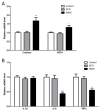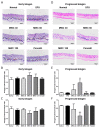Effects of the Complex of Panicum miliaceum Extract and Triticum aestivum Extract on Hair Condition
- PMID: 37892488
- PMCID: PMC10609892
- DOI: 10.3390/nu15204411
Effects of the Complex of Panicum miliaceum Extract and Triticum aestivum Extract on Hair Condition
Abstract
Proso millet (Panicum miliaceum L.) and common wheat (Triticum aestivum L.) have been used as major crops in multiple regions since ancient times, and they contain various nutrients that can affect human hair health. This study investigated the various biological effects of a complex of millet extract and wheat extract (MWC) on hair health. Human immortalized dermal papilla cells (iDPCs) for an in vitro study and an anagen-synchronized mouse model for an in vivo study were employed. These findings revealed that the application of the MWC in vitro led to an increase in the mRNA levels of antioxidant enzymes (catalase and SOD1), growth factors (IGF-1, VEGF, and FGF7), and factors related to hair growth (wnt10b, β-catenin) while decreasing inflammatory cytokine mRNA levels (IL-6 and TNFα). The mRNA levels of hair follicles (HFs) in the dorsal skin of the mouse model in the early and late telogen phases were also measured. The mRNA levels in the in vivo study showed a similar alteration tendency as in the in vitro study in the early and late telogen phases. In this model, MWC treatment elongated the anagen phase of the hair cycle. These findings indicate that the MWC can suppress oxidative stress and inflammation and may elongate the anagen phase by enhancing the growth factors involved in the wnt10b/β-catenin signaling pathway. This study suggests that the MWC might have significant potential as a functional food for maintaining hair health.
Keywords: anagen elongation; antioxidant; complex of millet extract and wheat extract; functional food ingredient; growth factor; hair health.
Conflict of interest statement
The authors declare no conflict of interest.
Figures







Similar articles
-
Collagenase IV plays an important role in regulating hair cycle by inducing VEGF, IGF-1, and TGF-β expression.Drug Des Devel Ther. 2015 Sep 25;9:5373-83. doi: 10.2147/dddt.s8912. eCollection 2015. Drug Des Devel Ther. 2015. PMID: 26451090 Free PMC article.
-
Effect of Plantago asiatica L. extract on the anagen phase in human hair follicle dermal papilla cells.J Cosmet Dermatol. 2023 Aug;22(8):2324-2332. doi: 10.1111/jocd.15720. Epub 2023 Mar 31. J Cosmet Dermatol. 2023. PMID: 36999450
-
Topical Application of Oleuropein Induces Anagen Hair Growth in Telogen Mouse Skin.PLoS One. 2015 Jun 10;10(6):e0129578. doi: 10.1371/journal.pone.0129578. eCollection 2015. PLoS One. 2015. PMID: 26060936 Free PMC article.
-
Lagerstroemia indica extract regulates human hair dermal papilla cell growth and degeneration via modulation of β-catenin, Stat6, and TGF-β signaling pathway.J Cosmet Dermatol. 2022 Jul;21(7):2763-2773. doi: 10.1111/jocd.15081. Epub 2022 Jun 9. J Cosmet Dermatol. 2022. PMID: 35596731 Review.
-
Proso Millet (Panicum miliaceum L.) and Its Potential for Cultivation in the Pacific Northwest, U.S.: A Review.Front Plant Sci. 2017 Jan 9;7:1961. doi: 10.3389/fpls.2016.01961. eCollection 2016. Front Plant Sci. 2017. PMID: 28119699 Free PMC article. Review.
References
-
- Zhang B., Zhao Y., Cai Z., Caulloo S., McElwee K.J., Li Y., Chen X., Yu M., Yang J., Chen W., et al. Early stage alopecia areata is associated with inflammation in the upper dermis and damage to the hair follicle infundibulum. Aust. J. Dermatol. 2013;54:184–191. doi: 10.1111/ajd.12065. - DOI - PubMed
-
- Arck P.C., Handjiski B., Peters E.M.J., Peter A.S., Hagen E., Fischer A., Klapp B.F., Paus R. Stress inhibits hair growth in mice by induction of premature catagen development and deleterious perifollicular inflammatory events via neuropeptide substance P-dependent pathways. Am. J. Pathol. 2003;162:803–814. doi: 10.1016/S0002-9440(10)63877-1. - DOI - PMC - PubMed
MeSH terms
Substances
LinkOut - more resources
Full Text Sources
Miscellaneous

